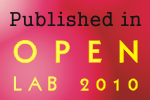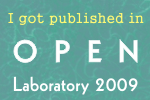Open Access: what’s in it for me?
One problem that I am facing is convincing colleagues of the utility of an Open Access publication. The usual arguments: more visibility, retention of the right to re-use material, the Greater Good, taxpayer access to taxpayer-funded research and so on don’t stick very well when faced with a $1500-$2500 or higher publication fee. These can be very big expenses if one is working on medium to small size grants, and where publication fees are sought, in part, from the College. Note: in many case the OA fees are not unaffordable; one would not request, in good faith, that the fees be waived or discounted by the publisher. But if one can use this money to pay the summer salary of a couple of more students, go to a conference, or upgrade / repair equipment, then the utility of shelling out this money for a publication seems marginal and pying this money for publication fees seems almost frivolous. In the US, funding agencies require, at most, that publications resulting from their funding would, be available on Pubmed Central within a certain time period and many non-OA publications comply, or they would lose the ability to publish a large chunk of NIH/NSF funded research projects. But doing so is not really timely OA. The bottom line is, if the grant is smaller than R01 size, many applicants would rather budget the expected $8000 of OA fees for the 3-4 year grant period for other line items that have a more palpable payoff, so to speak.
I don’t really have a point to this post, other than raising a problem that seems to be ignored, or marginalized, by many OA advocates. Not everyone operates on large grants. Many lab budgets leave very little room to buy a new laptop, let alone pay for an OA publication (typically the price of two of said laptops).




















I don’t follow OA that closely, but why don’t researchers just start a simple blog on typepad or wordpress and publish their information that way? I realize that this circumvents the peer review process in a lot of ways, but don’t see that issue as a horrible problem.
@Sean
No more horrible than ruining one’s career.
Peer review is central to science. Research not published in a peer reviewed journal is, essentially, worthless.
The whys & wherefores may be argued upon, but the quality of research, and the ability to keep on funding it are determined by the peer review process.
However, peer review critique is not the topic here…. 🙂
“One would not request, in good faith, that the fees be waived or discounted by the publisher.”
What’s the “good faith” cut off point for asking for a waiver?
Several Open Access journals say something like, “We will not hold back an article because of someone’s inability to pay,” but I have never seen any indications of how journals determine who is able to pay or not.
You could try getting your colleagues to add up what they’ve paid in page and color charges to toll-access journals, and ask them what they’d rather get for their money.
@Zen Faulkes
All good points. I think journals rely on the researcher’s sense of fairness, and maybe that of pride as well. Also, researchers who think they may not be able to afford the OA fee, may simply avoid publishing in an OA journal from the get-go.
@bill
Page charges are considerably lower that OA charges (the high end is ~$100 for overage: so may run up to $300 if it’s a really long paper). Color plates are expensive, true, but those charges can be controlled by avoiding unnecessary color plates. Usually 1-2 plates are given for free, YMMV. A color plate is still cheaper than OA (although it can be pricey!) Overall, my experience has been that page+color charges are still lower than OA fees.
Um, no, my whole point was that page and color charges at TA journals frequently add up to sums greater than the article processing charges at BMC, Hindawi or PLoS ONE, and some even exceed PLoS Biol and hybrid programs like AuthorChoice. RTFLink, where I provide some estimates of average page+color charges and compare to APC’s.
I completely agree that shelling out ~$1500/publication is not a trivial decision in many labs. Personally, I think the charge is ridiculous and should drop over time as new publishers come up with cheaper solutions. It should really not cost that much to publish a paper. In today terms what is needed to run a simple publishing company? Maybe a few full time editors, a web server, and some IT to keep the system running. Of course today’s publishers use a much more complex system, but there is no reason that we can’t minimize (or eliminate) their role in publishing using open-source software and changing the process slightly.
@bill
The list you provide seems somewhat askew. Research that gets published in a prestige journal usually involves considerable funding in the first place, and the authors are willing and able to pay extras to support whatever they feel will add impact to their publication: pages, color plate, supplementaries, videos etc. Putting it bluntly, if you managed to get a Science publication, you want, and can afford to, pimp out your paper. Of course, this also means that the research group(s) usually have the additional money to put into an OA publication. In that case, where the paper goes is really a matter of choice, or of peer-pressure regarding publication venue.
In any case, I was referring more to closed access niche journals, which charge little or nothing in page charges and color plates, as opposed to open access niche journals (e.g. most of BMC) which charge considerably more. You seem to have picked the few niche journals which are high-end. Again, I believe the OA payoff down the line makes it worth the sums, but those are seeming intangibles: a hard sell.
Well, I didn’t have a strategy when picking journals to look at, I just grabbed what came to mind or showed up on searches for official figures — so you’re right in that it may not be a usefully representative sample, and I don’t have data to say whether it is or isn’t.
You’re also right that niche journals are a different ecosystem altogether. The majority of OA journals do not charge any author-side fees at all (see, e.g. here), and there are >4400 entries in the Directory of OA Journals. My best estimate from Ulrich’s is that there are around 15,000 peer-reviewed STM journals, so TA outweighs OA but only by ~2:1 — once we get away from the Cell/Nature/Science fixation, surely somewhere in the DOAJ there is a no-fee OA alternative for most TA niche journals?
That makes the price competition moot — or turns it on its head, since most TA journals do charge at least some author-side fees (see the Kaufman-Wills study linked in my first link above). If you’re really hard up, surely a journal which charges you nothing at all is the best choice — and that is more likely to be a no-fee OA than a TA journal.
@Morgan Langille
“In today terms what is needed to run a simple publishing company?”
I was saying to my students yesterday that if I wanted to, I could probably start a new online journal for $50. Buy a domain name and some server space, ask a few colleagues to start reviewing manuscripts, and away you go.
On the other hand, if I were to want to launch a journal that actually distributed archival print copies to libraries around the world… that would be more expensive.
There might be a perceived difference in credibility because of that.
I’m with Bill on this one. OA makes economic sense to those who know what their options are. I also have to take issue with your claim that research not published in a traditional journal is worthless. First of all, it’s your community of peers that decides whether or not it’s worthwhile, and that can happen just as well on a blog as anywhere else. Surely you don’t mean that if someone blogs their research, then subsequently publishes and the paper is widely cited, that only after publication it is worthwhile?
People blog their research all the time, too. I published a method for fluorescently staining osteoclasts in paraffin embedded bone sections to the prestigious journal of My Blog and then subsequently in an open access journal (pending).
Surely I *do* mean that. P&T committees do not consider blog writing to be a publication. Grant review panels don’t consider blogging to be a publication. The latter determine whether you have money to do your job and the former whether you actually have a job (usually based upon how much money you get from the latter). So peer-reviewed publications are the fundamental career-scientist coinage. As far as blogging is concerned, the value in this context are nil. There may be other values to blogging such as making yourself known “out there”, networking, recruitment etc.
Whether that is a good or bad situation may be argued about, but there it is.
Just to clarify previous comment: blogging is fun. I find it hones my writing skills, gives me visibility, a chance to vent, rant and net-socialize. I also keep better tabs on current happenings in my fields of interest by blogging about papers I read. Down the line some of this may translate to attracting graduate students to my lab, or leave an informal favorable impression with someone reviewing my manuscripts, grant proposals or request for promotion.
But blogging is not one of the things by which I am judged professionally.
I’m with Iddo on this. If you didn’t publish your work in a peer reviewed journal, the places/people that count the most for the future of your career will not take it into consideration. Some people might even see time spent on blogging etc. as “not being serious”. Unfortunately, I don’t think this will change any time soon.
@Dr. Gunn
Ever heard of the Ingelfinger rule? Most journals will not publish something if they find out it’s already been put on a blog.
@Iddo
I was coming from the standpoint of other helping scientific community and not how is this information going to get me more funding or further my career.
sorry about the typo… I don’t see an edit function.
Under Open Access philosophy, Redalyc aims to contribute to the editorial scientific activity produced in and about Ibero-America making available for public consultation the content of 550 scientific journals of different knowledge areas: http://redalyc.uaemex.mx